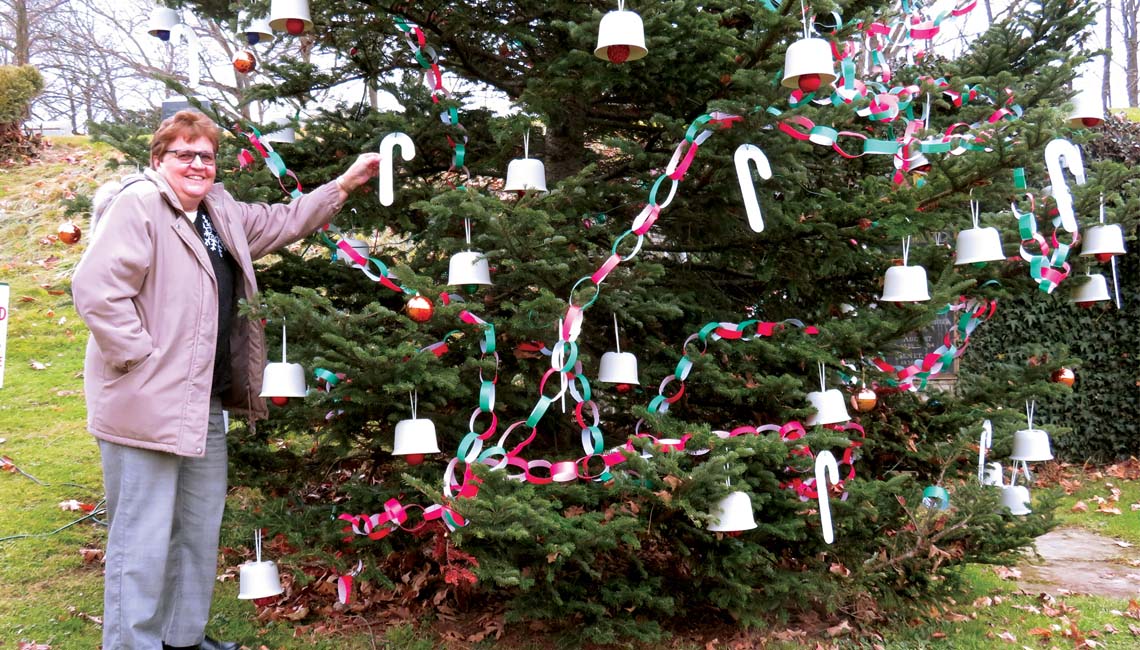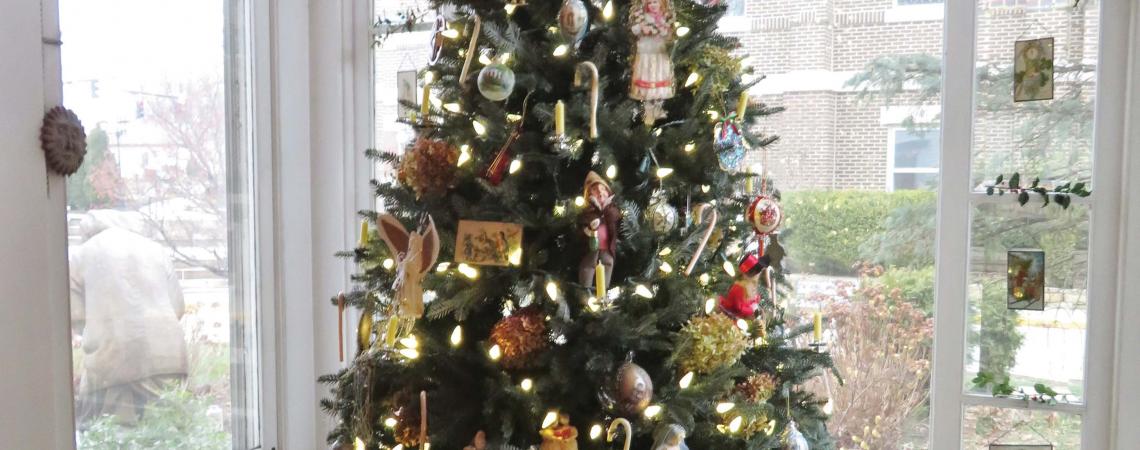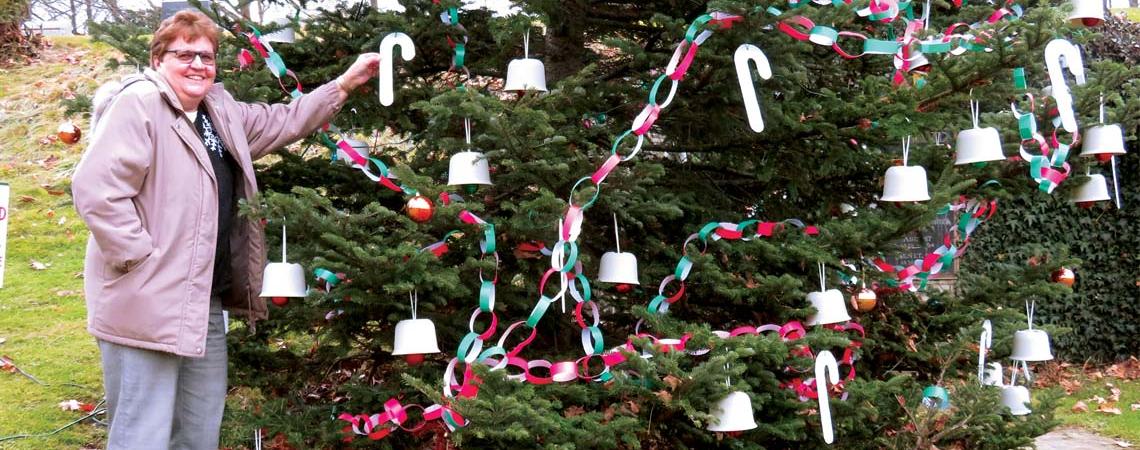Wooster Cemetery manager Kelvin Questel has an up-close view of the parade of visitors to one particular graveside each holiday season. His office, you see, is quite near the final resting place of one August Imgard (1826–1904), and the tree on that spot is quite the Yuletide draw.
“People come at all times of the day and evening to see the tree,” says Questel. “Many of them are interested in history, or they decorated the tree when they were kids and now bring their kids to see it.”
The Christmas tree in the window of the rectory at St. Mary of the Immaculate Conception Church
Although Questel is unsure when the tradition of trimming Imgard’s tomb-side tree began, he does know why the ritual is unique to Wooster: In 1847, Imgard was a 19-year-old immigrant from Germany living at his brother’s house in Wooster and grew homesick for his native country’s customs, especially around Christmastime. So, he went to the woods near Apple Creek, cut down a spruce tree, and positioned it in a window, adorned with nuts, apples, sweets, and candles. He even had a tinsmith make a star for the top of the tree.
The novelty of turning an evergreen into an indoor decoration caused something of a sensation. People from all over town came to gaze at Imgard’s tree in wonder and amazement, and within a few years, Christmas trees were common in Wooster. Imgard, a tailor by trade, became a prosperous and respected citizen. He built a large, handsome house where, every Christmas, he delighted in decorating an elaborate tree for his children and grandchildren. Imgard died in 1904, and his home is now the rectory at St. Mary of the Immaculate Conception Church.
Mistaken identity
For decades, newspapers published stories about Imgard that proclaimed Wooster the home of the nation’s first Christmas tree. The town enjoyed that claim to fame until the 1940s, when William Schreiber, who taught German at the College of Wooster, discovered that Christmas trees existed in other American towns as early as 1832 — Cincinnati probably even had an 1830s tree. Schreiber’s research, however, verified Imgard’s importance locally. “The professor determined it was the first Christmas tree in both Wooster and Wayne County,” says Questel.
The National Confectioners Association also credits Imgard with commencing the custom of hanging candy canes on Christmas trees. A choir master in Germany supposedly originated candy canes by giving children sugar sticks shaped like shepherd’s hooks. Since candy canes didn’t have peppermint flavoring or red stripes until about 1900, the ones Imgard used as decorations would have been solid white.
Years ago, Questel swapped a Norway spruce that had stood beside Imgard’s tomb for the current Fraser fir. “Fraser firs don’t have prickly needles, and that makes them nicer to decorate,” he says. Because of the parish’s connection to Imgard’s home, St. Mary School students often make ornaments for the tree, and community volunteers help light and decorate it as well. In 2020, Wayne County visitors bureau director Martha Starkey, her husband, Paul Starkey, and her co-worker Jacki Chamberlain created artificial candy canes for the Fraser fir. To ensure the candy canes were durable, they fashioned them from corrugated plastic, and in a nod to Imgard, made them white.
Memory eternal
The gravesites of many prominent townspeople are in the cemetery — including Schreiber, baseball player Dean Chance, and founding fathers whose surnames (Beall, Bever, Larwill) now grace Wooster’s streets. But only Imgard is legendary enough to merit a sign that says, “Brought to Wooster, The First Christmas Tree, in 1847” — a reminder written in bright red of why the town continues to keep his name alive.
Imgard’s legacy lives on in several conspicuously merry and bright trees. In addition to Imgard’s twinkly Fraser fir, Wooster Cemetery is the site of a Chamber of Commerce-sponsored community Christmas tree that is so tall it can be seen from downtown. The public square boasts a children’s Christmas tree, and in the spirit of the season, Father Stephen Moran, who currently resides in St. Mary’s rectory, displays an old-fashioned tree — complete with candy canes and candles that would make Imgard proud — in the dining room’s bay window.
Questel usually lights the Fraser fir at Imgard’s tomb on the Sunday after Thanksgiving, but since the 20-foot tree is getting too big to easily decorate, he is already planning its replacement. “Remembering Imgard with a Christmas tree is a neat tradition,” he says. “We want to keep it going.”
Want to know more about Wooster’s Christmas trees and celebrations?
Information about August Imgard, Christmas trees, and holiday events is available from Wooster Cemetery (330-264-9090; www.facebook.com/WoosterCemetery); the Wayne County Convention and Visitors Bureau (800-362-6474; www.wccvb.com); Main Street Wooster (www.mainstreetwooster.org); and Wooster Area Chamber of Commerce (www.woosterchamber.com).











